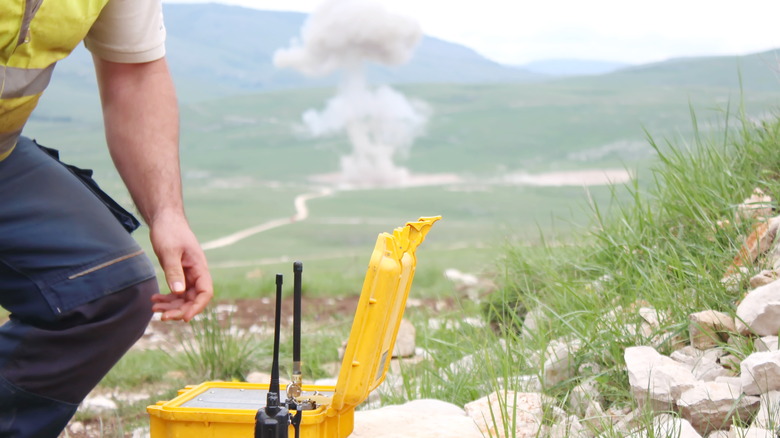What's The Difference Between TNT And Dynamite?
Anyone who's ever watched an old Sunday morning cartoon has seen characters try to blow each other up with a plunger of TNT or a stick of dynamite. Without giving it a second thought, many of us assume TNT and dynamite are the same ... so what is the difference between the two explosives?
The person who discovered dynamite was Alfred Nobel — also the creator of the Nobel Peace Prize — who experimented with all types of explosives throughout his life (via History of Yesterday). Dynamite was significantly more powerful than the other current explosive in use at the time, such as black powder.
The main issue Nobel had with dynamite was how to safely handle and detonate such a sensitive explosive. Dynamite was originally just made with a clear liquid called nitroglycerine, which was very volatile on its own. In 1864, five people were killed in a dynamite factory explosion, including Nobel's brother, Emil. The accident spurred Nobel to dedicate his life to making dynamite safer. Nobel patented nitroglycerine in 1867, selling the product in a paste to make it more stable. He later added a blasting cap (or detonator).
How to spot the true difference
Dynamite detonators had the "plunger box with a wire attached" look you might remember from the cartoons — and it really did create huge explosions. Since dynamite was now stable enough to not explode just from heat or pressure alone, it became very popular through the 1880s. There were lots of uses: it cleared the way for miles of railroad tracks and roads, blasted holes into mountains to create tunnels, and formed canals.
TNT was discovered by Julius Wilbrand in Germany around the 1860s. Wilbrand was trying to create a yellow dye with the chemical, not realizing that his mixture actually had the ability to start giant explosions. Created in 1863, it is slightly more stable than dynamite, but according to Mental Floss, TNT is very toxic, which makes it a challenge to manufacture. To make it safer to use, TNT often gets mixed with other chemicals, like powdered aluminum, which creates an explosive for industrial use. This worked especially well for people who wanted to blast holes for wells or other underwater areas. It was the main choice for the U.S. Army for shells, grenades, and bombs for decades. Aside from having very different usages, dynamite and TNT look quite different. The chemical inside of the dynamite stick is white, while TNT is yellow crystallized powder. While they act similarly and often get conflated with each other, these two explosives each have a unique place in history.

